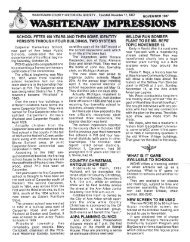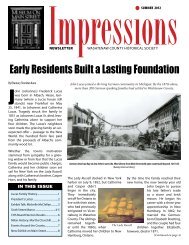Impressions - Washtenaw County Historical Society
Impressions - Washtenaw County Historical Society
Impressions - Washtenaw County Historical Society
Create successful ePaper yourself
Turn your PDF publications into a flip-book with our unique Google optimized e-Paper software.
Huron Street in 1924 portraying<br />
them together under an arbor has<br />
no historical basis, of course.<br />
"On December 30, 1824, the<br />
Post ma ste r Ge neral , J ohn<br />
Mc Lean, wrote to Allen informing<br />
his that Ann Arbor had been<br />
designated a post office with Allen<br />
as its postmaster.<br />
"Another letter dated February 7,<br />
1825, authorized Allen 'to meet t he<br />
southern mail at Detroit and go to<br />
that place by one road and return<br />
by t he other and have a post office<br />
established on each road." The<br />
roads referred to were that along<br />
the Huron River and the old Sauk<br />
Trai l through the woods."<br />
Go vernor Cass ap po i nted<br />
Rumsey and Oliver W. Wh itmore to<br />
serve three year terms as justices<br />
of the peace on March 31, 1825. It<br />
was then possible to execute a<br />
deed, for example, without all the<br />
parties having to travel to Detroit.<br />
"At about t he same time,<br />
Rumsey was apPo inted a captain<br />
of mi litia for Ann Arbor. Wh ile<br />
militia un its had existed for some<br />
time in both Wayne and Monroe<br />
cou nties, the population growth in<br />
the new counties now required better<br />
organization.<br />
"Two brigades were created for<br />
the Territory on April 3, 1826, each<br />
commanded by a brigadier<br />
general. The Fi rst Brigade comprised<br />
the counties of Monroe,<br />
Lenawee, <strong>Washtenaw</strong> and Wayne.<br />
Ann Arbor had company status. An<br />
interesting footnote is the fact<br />
Elisha was req uired to purchase<br />
his own mi litary coat which was<br />
sold, after his death, for $9.<br />
"The earl iest deed recording<br />
sale of a vil lage lot by Rum sey was<br />
dated June 11, 1825; for $60 he<br />
sold to Harvey Austin of Onondaga<br />
<strong>County</strong>, New York, four lots facing<br />
Liberty Street between First and<br />
Second Streets. He also included a<br />
third of an acre of the land (39<br />
ac res) between Allen's Creek and<br />
First Street that he had bought<br />
from Al len where his house stood.<br />
It was there that Austin set up the<br />
town's first tannery.<br />
Dr. Packard wrote of his first<br />
visit to Ann Arbor in 1825, "I forded<br />
the Huron River, and found to my<br />
joy a former friend Wal ker Rum sey<br />
was keeping a pioneer's hotel in a<br />
log house. This fami ly was very<br />
ki nd and hospitable and I fared<br />
well . . .<br />
"Ann Arbor contained seven log<br />
houses and one house part log and<br />
part frame (i.e. Rumsey's house).<br />
All the meeting I attended while<br />
there was a debating club of two<br />
members, Walker Rumsey and<br />
John Allen. The quest ion discussed<br />
was 'Is capital punishment<br />
right.' After a spirited discussion<br />
the quest ion was decided in the<br />
negat ive."<br />
YEAR·OLD ANN ARBOR<br />
WAS GROWING PLACE<br />
What was one·year·old Ann Arbor like?<br />
Founder John Allen "exaggerated only<br />
modestly when he wrote to his aunt in Ohio<br />
on February 20, 1825,":<br />
It is now twelve months since I settl·<br />
ed here, when there was not an in·<br />
habitant within ten miles - how dif·<br />
ferent is the scene now; in the village<br />
and neighborhood there is between<br />
thirty and forty families, many of<br />
whom are of the first respectability;<br />
roads have been opened in various<br />
directions; mills of every kind started;<br />
tradesmen putting their shops in<br />
operation by way of preparation for<br />
the flood of emigration that is ex·<br />
pected next summer; farmers busily<br />
engaged in fencing farms which<br />
nature has provided already clear for<br />
them - in short it already wears the<br />
appearance of an old settled country,<br />
except the want of Houses and<br />
Barns.<br />
--- Dr. Packard returned to Ann Ar·<br />
bor in the fal l and found that "a<br />
number of frame buildings had<br />
been put up du ri ng the summer,<br />
and Ann Arbor had two physicians,<br />
Dr. Lord and Dr. Denton, and I was<br />
the third."<br />
" Essential features of any<br />
American vil lage of the early 19th<br />
century were the grist mi ll and saw<br />
mill .. . A dispute arose between<br />
Rumsey and Allen regarding the<br />
first saw mill, however.<br />
Al len claimed he had borne personally<br />
the total expense of the<br />
mi ll 's construction , with the<br />
understanding that he (Allen)<br />
should thenhave the exclusive use<br />
of the mi ll for "such term as would<br />
be adequate to remunerate me for<br />
the cost of bu ilding."<br />
After building it, Al len sold it to<br />
George W. and James Noyes for<br />
$2,000 in payments secured by a<br />
mortgage on the prem ises.<br />
"Legally, Rumsey owned half the<br />
mi ll, thoug h Allen had borne the<br />
cost of construction, because they<br />
were join t owners of the land on<br />
wh ich it stood, and on May 24,<br />
1825, Rumsey had sold his half to<br />
George Noyes for $800.<br />
"On November 24, 1826, George<br />
Noyes was killed durin g a house<br />
ra ising in Ann Arbor. Because<br />
Noyes was found to be insolvent at<br />
his death, the mill property was<br />
seized and Allen lost heavily.<br />
With the completion of the Eri e<br />
Canal in 1825, hordes of emigrants<br />
m oved and in and through<br />
Michigan. By the end of the year,<br />
<strong>Washtenaw</strong> <strong>County</strong> could claim a<br />
popu lat ion of over 1,500, two thirds<br />
of whom had been added during<br />
that si ngle year.<br />
"Anxious to avoid having to<br />
travel to Detroit to conduct most of<br />
t hei r official business, Allen,<br />
Rumsey and others now urged the<br />
Governor and Legislative Council<br />
to 'organ ize' <strong>Washtenaw</strong> <strong>County</strong><br />
and make it independent from<br />
Wayne.<br />
According to the Detroit Gazette<br />
of December 13, 1825, delegates<br />
from around <strong>Washtenaw</strong> county<br />
had convened at Rumsey's house<br />
December 3 to nominate can·<br />
didates for county offices.<br />
There w as no i mmediate<br />
response but on November 20,<br />
1826, <strong>Washtenaw</strong> was f inally<br />
brought into organized existence.<br />
No longer would a citizen have to<br />
travel to Detroit to register a deed,<br />
probate an estate or settle a minor<br />
legal dispute.<br />
The county was divided into<br />
three townships, Ann Arbor, Dexter<br />
and Ypsilant i. These were gradually<br />
subdivided over the next few<br />
years until there were 20 in all.<br />
The first court was held in Ann<br />
Arbor on January 15, 1827, with<br />
Samuel Dexter presi ding as chief<br />
judge. Erastus Priest was accused<br />
of selling liquor in Ann Arbor in<br />
quantities less than one quart<br />
without a license (i.e liquor by the<br />
glass).<br />
Elisha Rumsey was one of the<br />
grand jurors wh o found sufficient<br />
evidence to bri ng Priest to trial the<br />
following day, but the j ury, after<br />
del iberating two hours, found<br />
Priest "not gu ilty."<br />
"With the 'flood of em ig ration'<br />
taverns besides that of Rumsey's<br />
quickly came into existence in Ann<br />
Arbor, such as the one operated by<br />
Priest. Most travelers considered<br />
Rumsey's the best, however, largely<br />
because of Mrs. Rumsey's cooking<br />
abi lity.<br />
Rumsey's also served not on ly<br />
as a meeting place but a place of<br />
4







